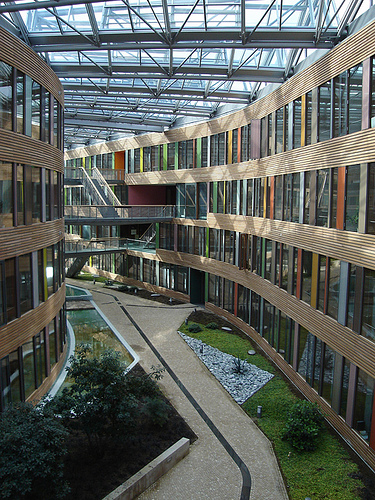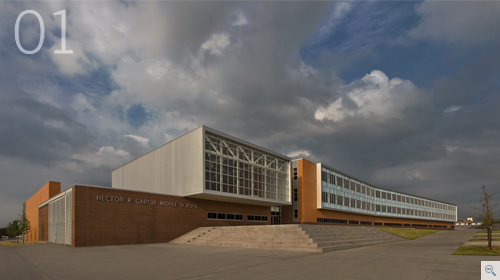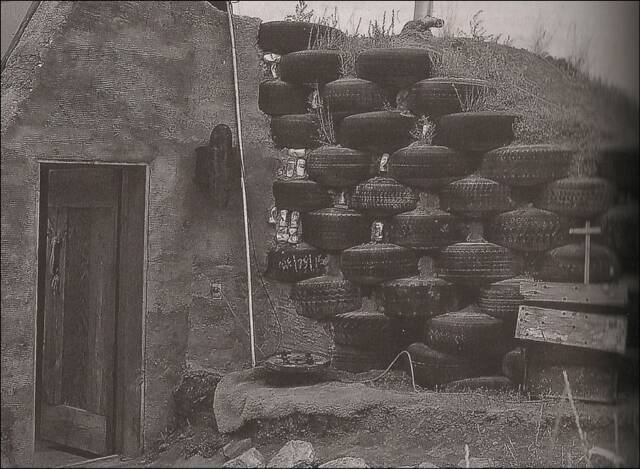“Green” Architecture
by Keith Hubrath
Gordon also explains that the community used recycled materials such as used tires, bottles, mounds of earth, mud bricks, and bales of hay to help design free-form houses. Shay Solomon found similar projects in the New Mexico desert called “spaceships” that started popping up in the late nineteen-seventies. Solomon is the author of Little House on a Small Planet: Simple Homes, Cozy Retreats, and Energy Efficient Possibilities, in which she describes different ways people can become more “green” using their own living space to suit there needs (2006).
These “earthships” are private residences tucked under the rolling hills, as Solomon describes, free from municipal water lines and the power grid. The author explains that these homes consist of two pieces: the cave and the greenhouse. The cave is mostly underground, containing only enough windows to capture the natural light to conduct everyday living, taking advantage of warm desert sands that act as an insulator, keeping down on heat and cooling cost. The cave is home to the majority of the living space within the “earthship”. The greenhouse is where numerous plants are grown to help support the family inside, reducing their need to go to the grocery store, thus saving on their overall carbon footprint by driving back and forth. Solomon also found that many of these “earthships” collect rainwater and produce their electricity through solar panels on the roof to help support their own sustainability (2006).
Fig 1: This is “earthship” in New Mexico utilized recycled tires to help build the walls of a partially buried home. Using recycled materials, utilizing the sun’s energy to provide power and grow plants, and the earth’s natural thermal properties, this “earthship” is very environmentally friendly.
While being very sustainable, as German architects Matthias Sauerbruch and Louisa Hutton argued, in Ursula Seibold-Bulmann’s essay, ”What does sustainability look like? Green architecture as an aesthetic proposition”, projects such as the “earthships” were not appealing to the eye. Sauerbruch and Hutton claimed that they often resembled “anti-authoritarian experimentalism, chicken-wire scruffiness, and a sometimes comical strand of DIY” (qtd. in Seibold-Bultmann, 5).
Alastair Gordon explains in her book that the idea of free form “green” architecture never fully flourished and inevitably died during the nineteen eighties. (2008) However, Christopher Hawthorne, noted architect critic for the Los Angels Times and author of the article “Emerald Cities”, and Shay Solomon both seem to agree that studies released in the past decade serve as a modern catalyst for environmentally conscious architecture.
Hawthorne explains that “U.S. buildings produce roughly half of global greenhouse-gas emissions every year” (par. 3) Said differently, Solomon uses a car analogy to describe the impact the construction of houses in the United States has on the environment: “A typical new house sends three to fine tons of waste to the landfills. It adds 30 tons of carbon dioxide to the atmosphere-about the equivalent of driving the family car around the world six times–and takes down three-quarters of an acre of forest in the process” (2006). This, as they both state, should explain why within the last decade there has been a recent uprising in environmentally conscious design.
Ursula Seibold-Bultmann also agrees that recent “green” buildings have become more visually appealing. She uses the example of Sauerbruch and Hutton who were commissioned to design the German environmental agency building, Umweltbundesamt, in Dessau Germany. Seibold describes the building, which opened in 2005, as looking like a
“…giant snake nestling around a glazed atrium and forum, and enfolds visitors in a welcoming and comfortably warm embrace. Its dynamically curved four-storey timber and glass facade, part rough and part smooth, is a radiant example of rhythm through colour, featuring as it does four horizontal bands of rectangular glass panels whose vibrant hues relate to the immediate surroundings of the building and range from lemon yellow to light green, lavender, pink, blue, vermilion, and burgundy red” (Seibold-Bultmann, 4).
.
Fig 2: The German environmental agency, or Umweltbundesamt, opened in 2005 in Dessau, Germany is an example of environmentally friendly architecutre that is appealing to the eye. The building uses vibrant glass panels of different colors and a large atrium to help welcome guests.
Barbra Crum and Steven Turckes, authors of the article “Sustainable School Design”, which appeared in the American School Board Journal in September of 2007, explain that these technologies, amongst others, can help make a school’s design more “green”. They both also explain that these technologies, which have become cheaper than before, make the proposition of building “green” more appealing (Crum and Turckes 2007).
Crum and Turckes use Hector P. Garcia Middle School in Dallas, Texas, which opened in 2007 as an example of how the technologies have helped make the school a success. The authors explain that going “green” was not originally in the plan because of the cost associated with purchasing technologies such as low-flow toilets and solar panels. However, because of scientific advances in architecture design, the group argues that the design of the school of itself can still be environmentally friendly (Crum and Turkes 2007).
Fig 3: Hector P. Garcia Middle School opened in 2007 in Dallas, Texas. The building takes advantage of northern light exposure to allow optimum lighting while keeping cooling cost down.
The authors both suggest that the buildings should take advantage of the sun’s natural light to help reduce energy consumption of lighting the building, by using large windows to let the light in. Also, they suggest that the classrooms take full advantage of the northern light which helps reduce cooling needs, while still supplying plenty of light. The group also says that the use of native plants in the surrounding areas may help reduce the use of water. These simple designs, as the group claims, make for an inexpensive way to be environmentally friendly (Crum and Turkes 2007).
Works Cited
Crum, Barbara, and Steven Turkes.. "Sustainable School Design." American School Board Journal  194.9 (Sep. 2007): 68-70. Academic Search Premier. EBSCO. Johnson & Wales University
194.9 (Sep. 2007): 68-70. Academic Search Premier. EBSCO. Johnson & Wales University 





 Library, Charlotte, NC. 11 Feb. 2009. <http://search.ebscohost.com/login.aspx?direct=true&db=aph&AN=26215125&site=ehost-live>.
Library, Charlotte, NC. 11 Feb. 2009. <http://search.ebscohost.com/login.aspx?direct=true&db=aph&AN=26215125&site=ehost-live>.
DSC04281 on Flickr - Photo Sharing! Flickr. 11 Mar. 2007. 15 Feb. 2009 <http://flickr.com/photos/patrickmchugh/417777972/>.
Gordon, Alastair. Spaced Out : Crash Pads, Hippie Communes, Infinity Machines, and Other Radical Environments of the Psychedelic Sixties. Minneapolis: Rizzoli International Publications, I Incorporated, 2008.
Hawthorne, Christopher. "EMERALD CITIES." Sierra 94.1 (Jan. 2009): 24-103. Academic Search 

 Premier. EBSCO. Johnson & Wales University Library, Charlotte, NC. 11 Feb. 2009 <http://search.ebscohost.com/login.aspx?direct=true&db=aph&AN=35848857&site=ehost-live>.
Premier. EBSCO. Johnson & Wales University Library, Charlotte, NC. 11 Feb. 2009 <http://search.ebscohost.com/login.aspx?direct=true&db=aph&AN=35848857&site=ehost-live>.
Perkins and Will Commercial Building Architecture Projects, Office Building Architecture Projects. Perkins+Will. 16 Feb. 2009 <http://www.perkinswill.com/projects/project.aspx?id=147>.
Salomon, Shay, Nigel Valdez, and Frances Moore Lappe. Little House on a Small Planet: Simple Homes, Cozy Retreats, and Energy Efficient Possibilities. New York: Lyons P, 2006.
Stang, Alanna, and Christopher Hawthorne. “Eco-architecture Is Becoming More Attractive” Eco- architecture. Ed. Christina Fisanick. 129-136
Seibold-Bultmann, Ursula. "What does sustainability look like? Green architecture as an aesthetic proposition." Interdisciplinary Science Reviews 32.1 (Mar. 2007): 3-6. Academic Search Premier. EBSCO. Johnson & Wales University Library, Charlotte, NC. 10 Feb. 2009 <http://search.ebscohost.com/login.aspx?direct=true&db=aph&AN=25038048&site=ehost-live>.
Valdez, Nigel. “Outside The Entrance to an Earthship.” Photograph. New York: Lyons P, 2006, 70.


